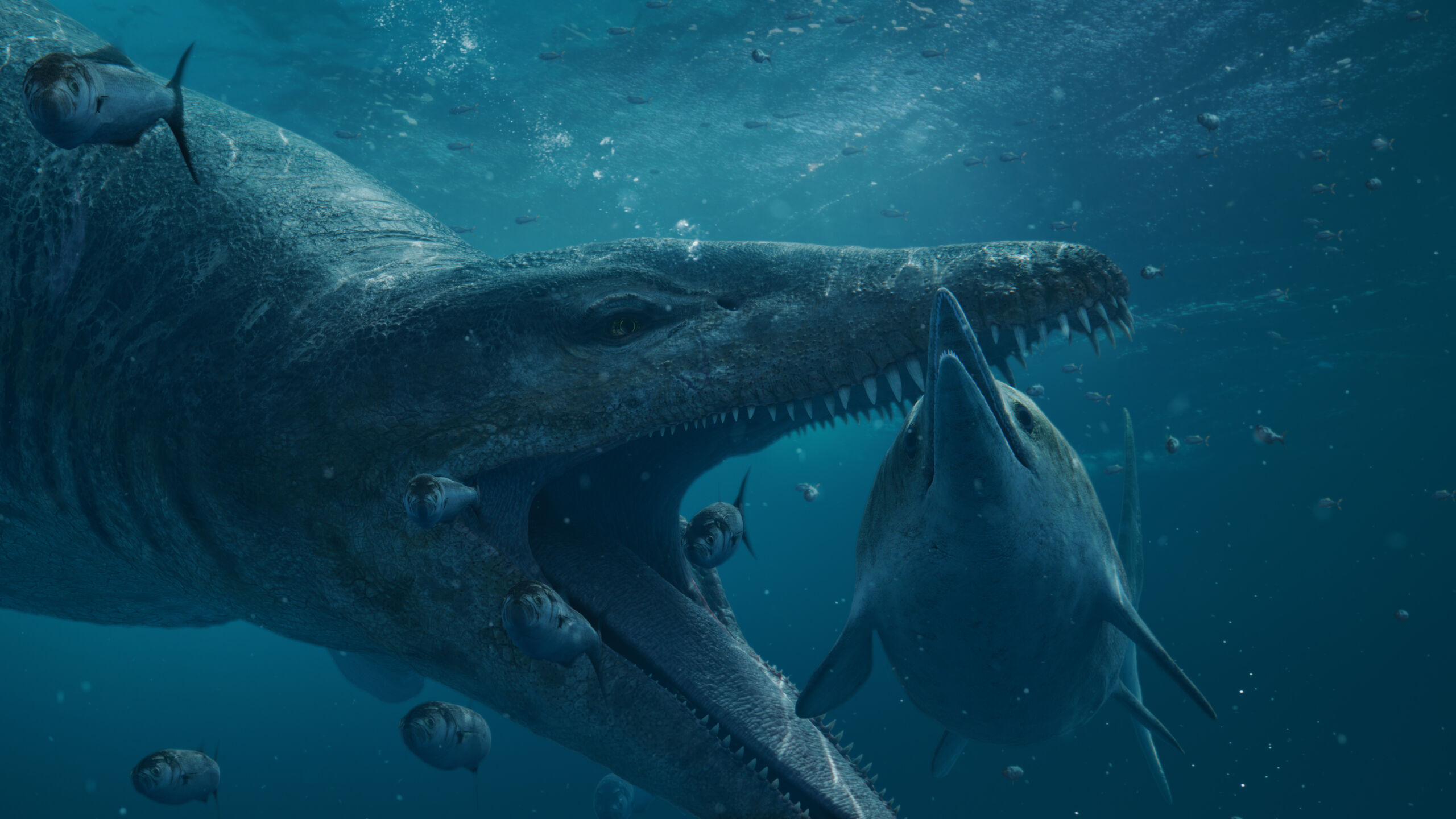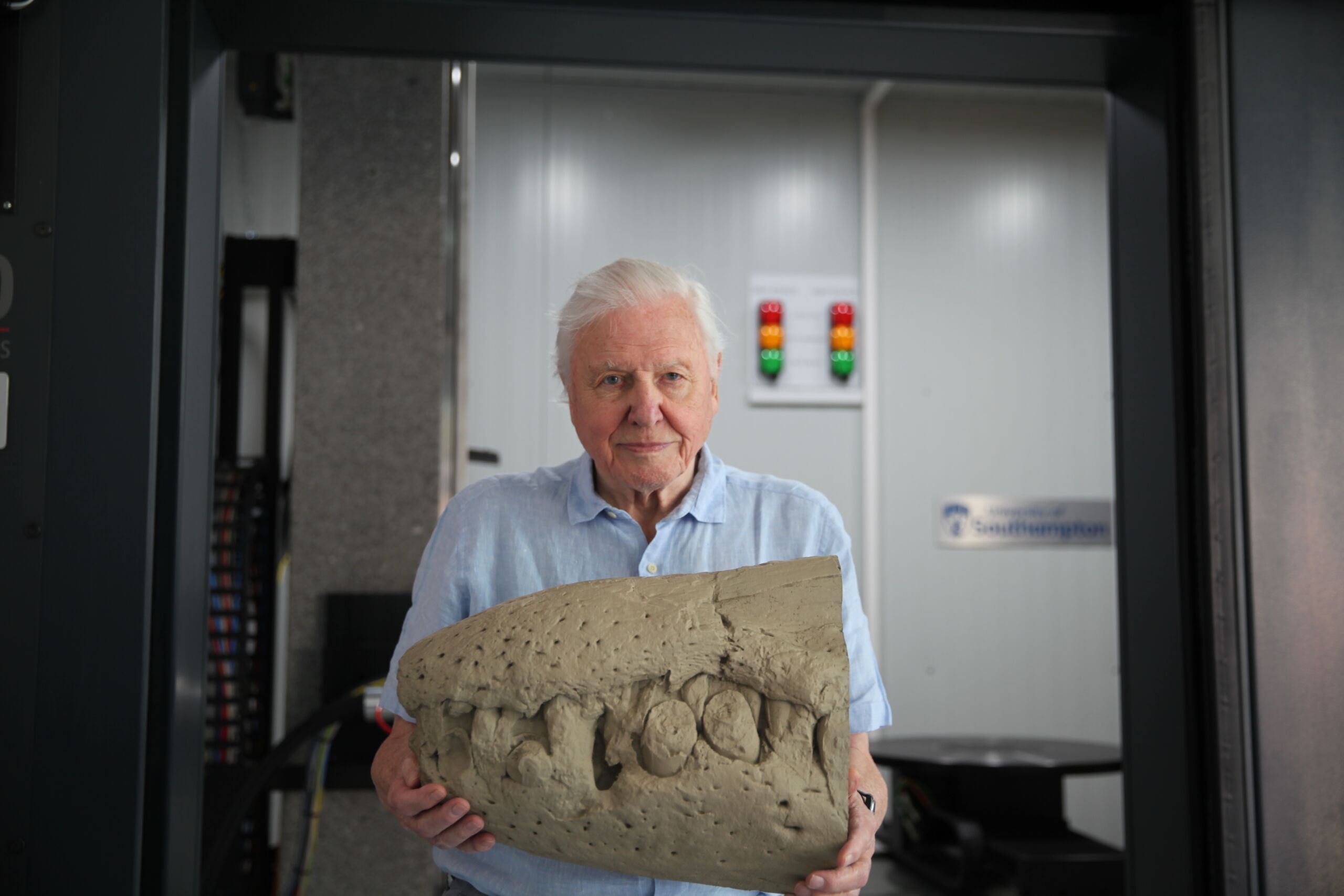
Pliosaur, T. rex of the sea, is the Jurassic monster of the moment
KIMMERIDGE, England — There was this thing on the beach. It looked like a tree trunk? But when they saw the fangs, the lethal grin of an apex predator, they knew.
They had found a pliosaur, one of the rarest of the rare, and the most fearsome marine reptile that ever lived — the saltwater version of Tyrannosaurus rex.
Think “sea rex” in the surf. Nothing but teeth, long as a school bus. With flippers.
The fossilized pliosaur snout was discovered in 2022 by a textile artist and self-described dinosaur hunter named Philip Jacobs, who happened upon it while walking in southern England, in an area known as the Jurassic Coast for all its prehistoric finds. The snout was a little smushed but amazingly intact, and its position on the beach led a team to find the rest of the skull on the nearby crumbling cliff face, which was excavated — via ropes and pneumatic jackhammers — by a former plumber and fellow fossil obsessive named Steve Etches.
The skull was winched up the cliff with the help of local farmer, stored in his barn and then — in a Hollywood ending almost too cute to be true — presented to the world on New Year’s Day by one of the most beloved men in Britain, naturalist Sir David Attenborough, in his latest BBC television documentary, “Attenborough and the Giant Sea Monster.”
The show will air for American audiences on PBS on Feb. 14.
The restored pliosaur fossil skull went on display here at the Etches Collection last month, and the little seaside museum has been packed with record crowds ever since.
Etches, who didn’t go to college, originally amassed his 2,800-fossil collection in his garage. It is today a destination museum, and the self-taught field paleontologist and fossil preparator is of global renown.
The 74-year-old Etches is lean, wiry and to-the-point. His decades spent digging up the past, what he calls “the stories from deep time,” have convinced him that life is lived with intensity because every species — even ours, especially ours? — has its expiration date.
“Maybe someone sees fossils in the drawer and asks, isn’t it boring?” He shook his head. “No, it is not boring. It is life and death and violence. It’s evade and evolve and —”
And brunch?
Because this pliosaur, if he or she were anything, was an eating machine, who dined on the primordial sharks and dolphin-like ichthyosaurs of its day like all-you-can-eat California rolls.

An artist’s rendering shows a pliosaur about to attack an ichthyosaur in the ocean, with small fish swimming nearby.
As Etches tells it, the creature was 32 feet long, with a bullet-shaped snout, a thick neck and a set of triangular striated teeth that could be almost a foot long. It was propelled by four paddling appendages and might have been capable of speeds of 30 mph.
Some suspect it swam very fast, like a penguin. Others think it might have moved a little slower, more like a sea turtle. No doubt it was a marine reptile, distinct from dinosaurs, which were terrestrial reptiles.
In his documentary, Attenborough seems giddy with the visions of all the chomping this monster could do, a creature he repeatedly refers to — patriotically? provincially? — as “our pliosaur.”
“What an extraordinary and terrifying thing,” says Attenborough, with undisguised glee.
The show cuts to the money shots of modern-day killer whales, great whites and saltwater crocs munching their prey as an illustration of how the pliosaurs might have dined.
“It’s unimaginable,” says Attenborough, obviously imagining it.
At one point in the show, the nonagenarian naturalist himself grabs ahold of a mock pliosaur tooth in the lab and begins stabbing it into a quivering block of rubbery gel designed to mimic flesh.
Like Etches, Attenborough tells the audience, “I’ve been collecting fossils since I was a boy, and I haven’t yet got tired of it.”
Not boring at all.
Etches, who had never climbed on a rope before he dangled off the cliff face to save the pliosaur fossil from tumbling into the sea, is an expert on the Kimmeridgian deposits that line the coast outside his front door, an ancient ocean floor laid down 157 million to 152 million years ago in the Jurassic Period.
The pliosaur that he and his colleagues excavated and study settled into the muck on a shallow sea then located around the spot where northern Morocco is today. Etches imagines that the warm tropical waters, beneath humid skies saturated with carbon dioxide, made for quite the habitat.
“It was absolutely teeming with life,” he said, filled with creatures now long gone, but with many others — and their evolved kin — still around today.

David Attenborough holds a 3D-printed model of the pliosaur snout fossil at Britain’s Southampton University.
In the documentary, Attenborough, as eager as a schoolboy, asks Andre Rowe, an American paleobiologist at the University of Bristol, his thoughts comparing pliosaurs and dinosaurs.
Rowe tells Attenborough, “In America, we got our big tyrannosaurs and our big triceratops, but the U.K. is great for marine reptiles.”
This gets a laugh. “It’s nice to hear it,” says the naturalist, who then probes: “Okay, let me ask you the million-dollar question. In a battle between T. rex and our pliosaur, who is going to win?”
Rowe describes the two as the apex predators of their respective ecosystems but concludes, “As much as it pains me and brings a tear to my eye to admit it, I think T. rex is going to lose this fight.”
Etches believes that the rest of the pliosaur is waiting to be excavated from the cliff face. “I am convinced,” he said. They are trying to raise the funds — about $300,000 — to recover the whole fossilized skeleton, which might measure 30 feet or more, and reveal vertebrae, ribs, flippers, tail — and even fossilized stomach contents. It is a race against time, as the exposed mudstone cliffs turn into wet clay with every storm.
If and when they recover the rest of the monster, where will they display it?
“It’s too big for the museum,” Etches said.
But he’s thinking about an extension.
News Related-
Antoine Dupont still hurt by 'injustice' of World Cup loss to Springboks
-
China's New Aircraft Carrier Begins Catapult Testing
-
Aircraft Downed Inside Russia By Patriot System: Ukrainian Air Force
-
“Am I Prog’s Taylor Swift? That’s a debate that could run and run”: why Peter Hammill re-recorded his Enigma-era albums
-
Car With Pro-Russian Fighters Blown Up by Resistance: Exiled Mayor
-
Europe and African nations must find effective common ground in dealing with migration influx
-
Springbok lock opts not to renew contract with URC team
-
Pravin Gordhan’s deathly legacy: A threat to SA’s economic future
-
Antoine Dupont STILL hurt by ‘injustice’ of Rugby World Cup loss to Springboks
-
Rubber stamping NHI Bill will have damaging consequences for SA for generations
-
Inside horrific conditions Hamas hostages suffered including losing 15lbs in 50 days
-
After the Bell: SA’s NHI healthcare disaster starts right here
-
Gupta-linked development land for sale
-
Gary Neville begrudgingly claims brilliant Man Utd midfielder ‘looked like a Man City player’ in Everton mauling
